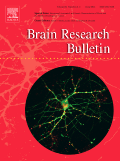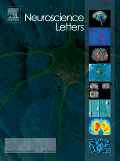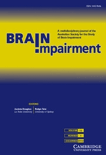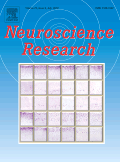
BRAIN RESEARCH BULLETIN
Scope & Guideline
Advancing the frontiers of neuroscience research.
Introduction
Aims and Scopes
- Neuroinflammation and Neuroimmune Interactions:
Research frequently addresses the role of neuroinflammation in various neurological conditions, exploring how immune responses influence brain health and disease states. - Cognitive Function and Behavioral Neuroscience:
A significant focus is placed on understanding the mechanisms underlying cognitive functions, including memory, learning, and the impact of stress and trauma on these processes. - Neuroprotection and Neuroregeneration:
The journal publishes studies on neuroprotective strategies and the potential for regeneration in the nervous system, investigating various pharmacological and non-pharmacological interventions. - Molecular Mechanisms of Brain Disorders:
Research often delves into the molecular pathways involved in brain disorders, including the role of non-coding RNAs, signaling pathways, and genetic factors. - Animal Models and Experimental Approaches:
Utilization of diverse animal models to simulate human neurological conditions is a consistent methodological approach, facilitating the translation of findings to clinical applications.
Trending and Emerging
- Gut-Brain Axis Research:
An increasing number of studies are exploring the relationship between gut microbiota and brain function, highlighting the significance of the gut-brain axis in mental health and neurological disorders. - Neuronal Plasticity and Neurogenesis:
Research focusing on the mechanisms of neuronal plasticity and the potential for neurogenesis in response to various stimuli is gaining traction, reflecting a deeper understanding of recovery processes in brain injuries. - Role of Non-Coding RNAs:
There is a rising trend in the investigation of non-coding RNAs, particularly in their roles in regulating gene expression and their implications in neurodegenerative diseases. - Psychobiotics and Mental Health:
Emerging studies are examining the therapeutic potential of psychobiotics, emphasizing their role in modulating mental health through gut microbiome interventions. - Technological Advancements in Neuroscience:
Innovative techniques such as advanced imaging methods, optogenetics, and CRISPR technology are becoming increasingly prevalent in studies, enhancing the exploration of brain functions and disorders.
Declining or Waning
- Traditional Pharmacological Approaches:
There seems to be a waning interest in conventional pharmacological treatments for neurological conditions, as research increasingly focuses on novel therapeutic strategies and integrative approaches. - Basic Neuroanatomy Studies:
Research purely centered on neuroanatomy without a functional or clinical context appears less frequently, signaling a shift towards studies that integrate anatomy with functionality and disease mechanisms. - Single-Factor Studies:
There is a noticeable decline in studies that investigate single factors in isolation, with a growing trend towards multi-factorial and systems-level approaches in neuroscience research.
Similar Journals

AIMS Neuroscience
Bridging disciplines in the dynamic world of neuroscience.AIMS Neuroscience is an esteemed open-access journal published by the American Institute of Mathematical Sciences (AIMS), dedicated to advancing the field of neuroscience since its inception in 2014. With a robust ISSN of 2373-8006 and an E-ISSN of 2373-7972, this journal aims to provide a platform for innovative research and scholarly discourse that spans the diverse and dynamic landscape of the neuroscience discipline. As of 2023, it holds a respectable Q3 category ranking in the miscellaneous neuroscience field and ranks #65 out of 113 in general neuroscience according to Scopus, positioning it in the 42nd percentile for impact. AIMS Neuroscience encompasses a broad scope of topics, from neurobiology and cognitive neuroscience to computational models and neuroengineering, making it a vital resource for researchers, professionals, and students alike. The journal's commitment to open access ensures that cutting-edge research is freely available, fostering collaboration and knowledge sharing within the global neuroscience community.

NeuroSci
Advancing Neuroscience Through Open CollaborationNeuroSci is an esteemed open-access journal published by MDPI, dedicated to advancing the field of neuroscience through high-quality research dissemination. Operating under the E-ISSN 2673-4087, this journal aims to foster collaboration and innovation by providing a platform for original research articles, reviews, and theoretical studies that address the complexities of the brain and nervous system. NeuroSci encourages submissions from a wide array of disciplines including cognitive neuroscience, neurobiology, neurophysiology, and neuropsychology, making it an essential resource for researchers, professionals, and students alike. With its commitment to open accessibility, NeuroSci ensures that groundbreaking findings are readily available to the global community, thereby enhancing the impact and exchange of knowledge in neuroscience. The journal is located at ST ALBAN-ANLAGE 66, CH-4052 BASEL, SWITZERLAND, contributing to the reputation of MDPI as a leading publisher in the academic landscape.

Journal of Neuroinflammation
Advancing the understanding of neuroinflammation and its impact on the brain.Journal of Neuroinflammation is a premier open-access journal published by BMC that has been at the forefront of research in the field since its inception in 2004. With a strong focus on the intricate interplay between the nervous system and immune responses, this journal aims to create a forum for the dissemination of high-quality research that informs our understanding of neuroinflammation and its implications in neurological disorders. Positioned in the top quartile across multiple categories including Cellular and Molecular Neuroscience, Immunology, and Neurology, the journal ranks impressively within the Scopus database, ensuring visibility to the global research community. The Journal of Neuroinflammation provides a vital platform for researchers and professionals to share groundbreaking findings, methodologies, and reviews that advance science and foster collaboration. With its commitment to open access, the journal ensures that its content is accessible to a broad audience, enhancing the dissemination of knowledge in this critical field of study.

NEUROSCIENCE LETTERS
Advancing Insights into Nervous System Complexities.NEUROSCIENCE LETTERS is a distinguished journal published by ELSEVIER IRELAND LTD, focusing on disseminating impactful research across the field of neuroscience. With its ISSN 0304-3940 and E-ISSN 1872-7972, the journal serves as a vital platform for researchers, professionals, and students aiming to explore the complexities of nervous system function and related disorders. Since its inception in 1975, NEUROSCIENCE LETTERS has contributed significantly to the field, currently positioned in the Q3 category for Miscellaneous Neuroscience, with a respectable Scopus rank of 52/113, placing it in the 54th percentile among its peers. The journal is published in Ireland and offers a comprehensive repository of scientific insights, methodologies, and innovative findings that advance our understanding of neurological phenomena. While not an open-access journal, it remains an essential resource for the latest advances in neuroscience research and the academic community’s collective knowledge.

Brain Impairment
Bridging research and application in cognitive health.Brain Impairment, published by Cambridge University Press, is a pivotal academic journal dedicated to advancing the understanding of neurological conditions and cognitive processes. With its ISSN 1443-9646 and E-ISSN 1839-5252, this esteemed journal has been at the forefront of research in the fields of Behavioral Neuroscience, Cognitive Neuroscience, and Neuropsychology since its inception in 2004. Covering a broad scope, it addresses critical insights into brain function, impairments, and therapies, making it a valuable resource for researchers, clinicians, and students alike. Brain Impairment holds various rankings, including Q4 in Behavioral Neuroscience and Q2 in Speech and Hearing, reflecting its significance in the academic community. While the journal operates under print access, its rich content serves as an essential reference for professional development and scholarly discussion in the UK and beyond. Researchers and practitioners can rely on this journal to provide cutting-edge research and reviews that inform clinical practice and shape future studies in neurology and cognitive neuroscience.

NEUROPSYCHOLOGY REVIEW
Advancing Understanding in Neuropsychological ScienceNEUROPSYCHOLOGY REVIEW is a prestigious journal published by Springer, dedicated to the exploration of cognitive processes and behavior through neurological and psychological perspectives. With its ISSN 1040-7308 and E-ISSN 1573-6660, this journal holds a distinguished position in Q1 of the Neuropsychology and Physiological Psychology category, ranking at #3 out of 76 with an impressive 96th percentile in Scopus. Since its inception in 1990, it has provided a critical platform for researchers, professionals, and students to disseminate and engage with comprehensive reviews and empirical research, promoting a deeper understanding of the interplay between neural mechanisms and psychological phenomena. Aimed at fostering interdisciplinary collaboration and advancement in the field, NEUROPSYCHOLOGY REVIEW invites contributions that push the boundaries of knowledge and stimulate ongoing debates in neuropsychology, making it an invaluable resource for anyone interested in the latest scientific advancements within this dynamic area.

Network Neuroscience
Pioneering Research in the Realm of Network ScienceNetwork Neuroscience is a premier open-access journal published by MIT Press, focusing on the interdisciplinary nexus of neuroscience, applied mathematics, artificial intelligence, and computer science. Since its inception in 2017, the journal has established itself as a leading outlet for innovative research and cutting-edge methodologies, ensuring disseminated knowledge is freely accessible to all. With an impressive Q1 ranking in multiple categories including Applied Mathematics, Artificial Intelligence, Computer Science Applications, and Neuroscience, it serves as a vital platform for scholars, professionals, and students to explore the intricate networks that underpin cognitive processes and brain function. The journal is committed to advancing the understanding of complex neural mechanisms through interdisciplinary approaches and remains a crucial resource for anyone engaged in the burgeoning fields of network science and neuroscience research.

BRAIN RESEARCH
Unlocking the mysteries of the brain, one study at a time.BRAIN RESEARCH is a premier journal published by Elsevier, specializing in the intricate domains of neuroscience, developmental biology, and molecular biology. Established in 1966, this esteemed publication has become a cornerstone for researchers, professionals, and students dedicated to advancing our understanding of brain function and disorders. With an impressive impact factor and a consistent presence in the Q2 quartiles across key categories—such as Developmental Biology, Neurology, and Neuroscience—it stands out as an essential resource for disseminating innovative research and pioneering insights. The journal's scope encompasses both clinical and fundamental studies, fostering a multidisciplinary approach to the complexities of neural systems. Although it is not an open-access journal, BRAIN RESEARCH provides a vital platform for sharing progressive findings that can inspire future studies and contribute significantly to the evolutionary discourse in neuroscience. Based in the Netherlands, at RADARWEG 29, 1043 NX AMSTERDAM, BRAIN RESEARCH continues to shape the landscape of neuroscience research, inviting submissions that explore the latest discoveries and therapeutic strategies.

NEUROSCIENCE RESEARCH
Pioneering Research in Neural MechanismsNEUROSCIENCE RESEARCH, published by Elsevier Ireland Ltd, is a leading journal in the field of neuroscience, with a notable reputation for disseminating high-quality research that spans a variety of topics within the discipline. With an ISSN of 0168-0102 and an E-ISSN of 1872-8111, this journal serves as a vital platform for both established researchers and emerging voices in the field. Ranking in the Q2 quartile in both Medicine and Neuroscience categories, it has been recognized as a reliable source of innovative findings since its inception in 1984, with continuous publication through 2024. Although it does not currently offer Open Access options, the journal is indexed in Scopus, holding a significant position at Rank #48/113 in General Neuroscience, reflecting its contribution to advancing the understanding of neural mechanisms across various contexts. With its address anchored in Ireland, NEUROSCIENCE RESEARCH plays an essential role in bridging scientific inquiry and practical applications, making it an indispensable resource for researchers, professionals, and students dedicated to the burgeoning field of neuroscience.

NEUROCHEMICAL RESEARCH
Advancing the frontiers of neurochemical science.NEUROCHEMICAL RESEARCH, published by Springer/Plenum Publishers, is a pivotal journal in the fields of biochemistry, neuroscience, and cellular and molecular studies. With an impressive impact factor that positions it within the prestigious Q1 category in Biochemistry and Medicine and Q2 in Cellular and Molecular Neuroscience, it provides a robust platform for the dissemination of cutting-edge research findings. Since its inception in 1976, the journal has played a crucial role in bridging the gap between neurochemical processes and neurological health, making significant contributions to our understanding of brain function and disease. Researchers and professionals are encouraged to engage with a wealth of high-quality articles that not only advance the field but also inform clinical practices. Located in the heart of New York, the journal continues to uphold its reputation as a leader in promoting innovative research that is essential for both academic and applied sciences.